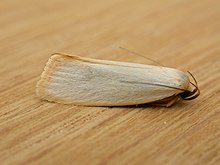| Curved-horn moths | |
|---|---|

| |
| Adult Xylorycta assimilis of the Xyloryctidae, photographed in Aranda (Australia) Note prominent "horns" and long antennae | |
| Scientific classification | |
| Domain: | Eukaryota |
| Kingdom: | Animalia |
| Phylum: | Arthropoda |
| Class: | Insecta |
| Order: | Lepidoptera |
| Clade: | Apoditrysia |
| Superfamily: | Gelechioidea Fracker, 1915 |
| Diversity | |
| 16-21 families (see text) | |
Gelechioidea (from the type genus Gelechia, "keeping to the ground") is the superfamily of moths that contains the case-bearers, twirler moths, and relatives, also simply called curved-horn moths or gelechioid moths. It is a large and poorly understood '"micromoth" superfamily, constituting one of the basal lineages of the Ditrysia.[1]
As of the 1990s, this superfamily was composed of about 1,425 genera and 16,250 species. It was estimated that only 25% of the species diversity of Gelechioidea had been described.[2] If this estimate is accurate, Gelechioidea will be one of the largest superfamilies of Lepidoptera.[1]
The name "curved-horn moths" refers to one of the few conspicuous features found in (almost) all Gelechioidea, and, at least in the more extreme developments, unique to them: the labial palps are well-developed (though not thickened), and form more or less gently curved protrusions whose end has a drawn-out, pointed tip. Their proboscis is generally well-developed, allowing for long-lived imagines (adults); the proximal part of the proboscis is scaly. Otherwise, the Gelechioidea vary extensively in habitus; most have small hind-wings with long, hairy fringes, though these are not easily seen in the living animal as they are tucked under the fore-wings at rest. The body is usually quite compressed, either dorsoventrally or laterally.[3]